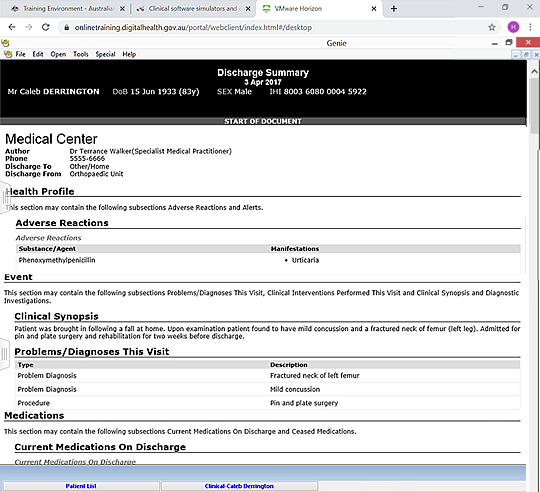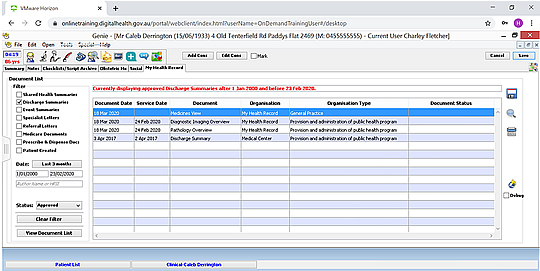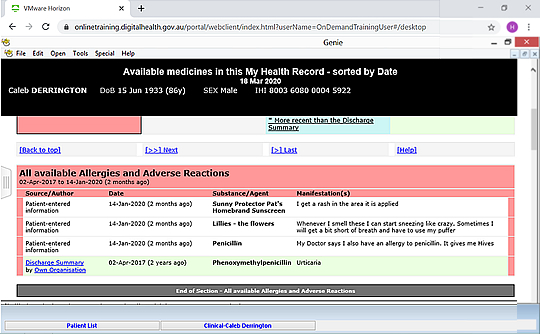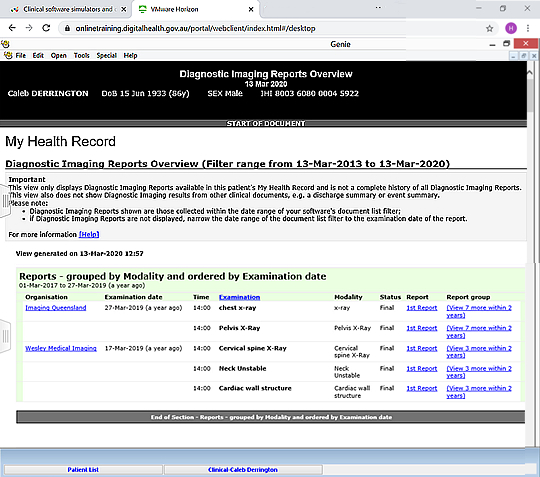Connecting specialists to patient health information with My Health Record
My Health Record can provide clinically relevant information that you do not already have in your local records. Rather than spending time chasing pathology reports or a list of current medications, you can save time by checking if this information is stored electronically in one secure location.
Having an additional source of information about a patient’s medical history can be beneficial when a patient visits you for the first time and for patients with a complex allergic disease who may have already seen other specialists, such as a gastroenterologist. As at February 2020 there are already more than 1.8 billion documents in My Health Record.
In this newsletter, we show you some of the information that may be available using a conformant clinical information system – Genie software. We have identified Genie as the software used by most clinical immunology/allergy specialists. Each software has its own 'look and feel' when displaying information in a patient’s My Health Record, so if you use another software, the screens may display differently.
The screen view below shows the document list in a patient’s My Health Record. This example shows:
- Medicines View
- Diagnostic Imaging Reports Overview
- Pathology Reports Overview
- Discharge Summary
Note that all screens are from training software and do not display real patient data.
Selecting the first row in the document list will display the Medicines View.
Medicines View
The Medicines View lists a patient’s prescribed and dispensed medications, and known allergies and adverse reactions in one place. The information in the Medicines View comes from the patient’s:
- Most recent (up to two years) prescription and dispense records and other PBS claims information.
- Most recent shared health summary and discharge summary.
- Recent event summaries, specialist letters and e-referral notes uploaded to the patient’s record.
- Personal health summary, that may include allergies or adverse reactions that they have entered.
An example is shown below.
[Image: Genie view of Medicines View in My Health Record]
As at February 2020 there are more than 112 million Medicine Documents in My Health Record
Diagnostic Imaging Reports Overview
The Diagnostic Imaging Reports Overview gives a snapshot of a patient’s imaging history, showing multiple reports within a specific date range in one page. This overview contains diagnostic imaging reports that participating diagnostic imaging providers have uploaded to your patient’s My Health Record, including reports ordered by other healthcare providers.
These reports will be immediately available to all members of your patient’s healthcare team. Your patient will be able to view the diagnostic imaging report seven days after it was uploaded to their My Health Record.
An example of a diagnostic imaging report is shown below.
[Image: Genie view of available Diagnostic Imaging Reports Overview in My Health Record]
As at February 2020 there are more than 6 million Diagnostic Imaging Reports in My Health Record
Pathology Reports Overview
You can view your patient’s pathology reports uploaded by participating pathology laboratories, including reports ordered by other healthcare providers. This allows you to see tests undertaken by general practitioners, paediatricians or other specialists who refer patients to you.
The reports will immediately be available to all members of your patient’s healthcare team and will be available to the patient in their My Health Record seven days after the report is uploaded. This gives you time to review the report and contact the patient to discuss the results before they can see the information in their record.
Pathology reports you have requested or have been nominated to receive will be sent directly to you using existing processes in your practice.
Where an existing state or territory legislation prohibits the disclosure of sensitive information, a pathology laboratory will not upload a report to My Health Record without the express consent of the patient.
[Image: Genie view of Pathology Reports Overview in My Health Record]
As at February 2020 there are more than 40 million Pathology Reports in My Health Record
Discharge Summary
Hospitals connected to the My Health Record system can upload a copy of a patient’s discharge summary to My Health Record. As of January 2020, 94% of public hospital beds are now connected and hospitals have uploaded over 1.5 million documents. (For more details, see the My Health Record statistics page.)

[Image: Genie view of Discharge Summary reports overview in My Health Record]
**When accessing a patient’s My Health Record, be mindful that it may not include a record of every interaction they have had with the health system or an up-to-date status of their health.
As at February 2020 there are more than 6 million Discharge Summaries in My Health Record
Clinical software simulator
A range of clinical software simulators is available to help you familiarise yourself with My Health Record using your own clinical information software. If you have not used My Health Record yet, these resources can help you navigate My Health Record before you start using it for your patients.
This is also a step-by-step guide to search, view and save clinical documents to My Health Record from Genie.
My Health Record Factsheet for ASCIA members
The National Allergy Strategy has developed a Fact Sheet for Clinical Immunology/Allergy Specialists about the benefits of My Health Record. The Fact Sheet and links to ASCIA newsletters about the project are available on the National Allergy Strategy website.
Other resources also being developed for ASCIA members, including a step-by-step guide to viewing a patient’s My Health Record and uploading information to the My Health Record.
Other digital health initiatives: Electronic prescribing
Electronic prescribing provides an option for prescribers and their patients to have an electronic prescription as an alternative to a paper-based prescription.
The Department of Health have made changes to Commonwealth PBS regulations to recognise an electronic prescription as an alternative to a paper prescription and are now working with the Agency, clinical software vendors, and states and territories health departments to implement electronic prescribing.
Electronic prescribing as part of COVID-19 National Health Plan
On 11 March 2020, the Commonwealth Government announced plans to fast-track the implementation of electronic prescribing to help protect people most at-risk in our community from exposure to COVID-19. This measure (expected to be available within 8-12 weeks) will allow a doctor to generate an electronic prescription that the patient will then be able to electronically share with their pharmacy, where the pharmacy is able to support the home delivery of medicines.
More information about fast-tracking electronic prescribing as part of the COVID-19 National Health Plan is available from the Department of Health.
A summary fact sheet about electronic prescribing is available from the Australian Digital Health Agency.
Kind regards,
Dr William Smith and Ms Karen Wong
Project Co-leads, National Allergy Strategy MHR Project



![[Image: Genie view of Medicines View in My Health Record] Genie Image 2a](/images/pics/mhr/Genie_Image_2a.jpg)


![[Image: Genie view of available pathology reports in My Health Record] Genie Image 5a](/images/pics/mhr/Genie_Image_5a.jpg)